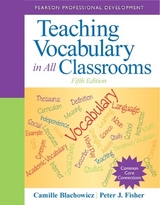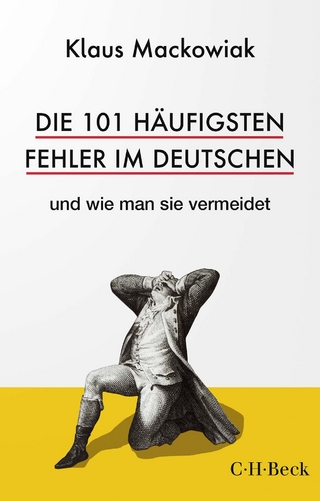
Teaching Vocabulary in All Classrooms
Pearson (Verlag)
978-0-13-500189-9 (ISBN)
- Titel erscheint in neuer Auflage
- Artikel merken
Camille Blachowicz is Professor of Education at the National College of Education of National-Louis University, where she is Director of the Reading Center and Reading Program. In her long career as an educator, Dr. Blachowicz has been a classroom teacher, team leader, and reading specialist as well as a university educator and staff developer. Her research has been supported by grants from the Spencer Foundation, the Fulbright Council and the International Reading Association. Dr. Blachowicz's many articles have been published in journals ranging from Educational Leadership and Reading Teacher to Reading Research Quarterly. She is also co-author of the books Reading Diagnosis: An Instructional Approach, Teaching Vocabulary in All Classrooms, Reading Comprehension: Strategies for Independent Learners, Reading Street, Fluency Development:From Research to Practice, and the chapter on vocabulary research for the third Handbook of Reading Research along with numerous book chapters and monographs. She also co-edits the series of staff development and in-service books Tools for Teaching Literacy along with Donna Ogle. As a staff developer, Dr. Blachowicz is a frequent speaker at national, local, and international conferences and at meetings of the International Reading Association, where she is a member of the publication committee. Dr. Blachowicz has also been named to the roster of Outstanding Teacher Educators in Reading by the International Reading Association. Currently, along with her teaching and writing, Dr. Blachowicz is co-directing two projects in urban and suburban schools: Literacy Partners, and the Everybody Reads Fluency Project. Peter Fisher is a professor of education at National College of Education of National-Louis University where he teaches graduate classes in literacy education. Peter taught in elementary and high schools in England prior to coming to the USA to complete his doctoral studies at SUNY at Buffalo. Peter’s research interests include vocabulary development and the teaching of storytelling. In 1997 he was inducted into the Illinois Reading Hall of Fame.
Contents
CHAPTER 1
Vocabulary in the Classroom: A Theoretical and Practical Perspective
What Does the Research Tell Us about Vocabulary
What Does It Mean to Know a Word?
What Is Effective Vocabulary Instruction?
Guideline 1: The Effective Vocabulary Teacher Builds a Word-Rich Environment in Which Students Are Immersed in Words for Both Incidental and Intentional Learning
Guideline 2: The Effective Vocabulary Teacher Helps Students Develop as Independent Word Learners
Guideline 3: The Effective Vocabulary Teacher Uses Instructional Strategies That Not Only Teach Vocabulary Effectively but Model Good Word-Learning Behaviors
Guideline 4: The Effective Vocabulary Teacher Uses Assessment That Matches the Goal of Instruction
Some Last Thoughts
Looking Back and Looking Ahead
Resources for Further Learning
CHAPTER 2
Learning Vocabulary from Context
Learning from Context
Early Word Learning
Learning Vocabulary from Storybook Reading
Teaching Vocabulary with Storybook Reading
Text Talk
Instructional Planning for Storybook Reading
Vocabulary Visits
The Nature of the Words to Be Taught
Teaching Vocabulary Using Other Methods
Encouraging Informal Word Learning
Developing Rich Language Environments
Classroom Labeling
Wide Reading
Using Technology
Learning to Problem-Solve with Context
Teaching About Context
Metacognitive Context Instruction
Using the Cloze Procedure
Self-Selected Vocabulary from Context
Using Contextual Methods to Present New Vocabulary
The Sentence Game
Create a Personal Context
Looking Back and Looking Ahead
For Further Learning
CHAPTER 3
Integrating Vocabulary and Reading Strategy Instruction
Developing Strategic Reading
What Is Strategic Reading?
How Is Strategic Reading Developed
Why Connect Vocabulary and Strategic Reading Instruction
Vocabulary in Strategic Reading Instruction
Classroom Examples
Starting with Graphic Organizers: Vocab-o-Grams
Starting with Writing: Story Impressions
Starting with Drama: Word Plays
Starting with Student Self-Evaluation: Knowledge Rating
Looking Back and Looking Ahead
For Further Learning
CHAPTER 4
Learning Vocabulary in Literature-Based Reading Instruction
Literature-Based Reading Instruction
The Core Book Approach
The Literature Unit Approach
The Individual Reading Approach
Figurative Language
Metaphors and Similes
Idioms
Looking Back and Looking Ahead
For Further Learning
CHAPTER 5
Learning Vocabulary in the Content Areas
Teaching New Meanings for Known Words
Teaching New Words for New Concepts
Teaching New Words for Known Concepts
CHAPTER 6
Vocabulary and Spelling Instruction Using Structural Analysis
Morphological Connections
Spelling and Morphemic Analysis
Etymology
CHAPTER 7
Assessing Vocabulary Knowledge
Assessment for Instruction
Standardized Measures of Vocabulary
What Are Standardized Measures?
Diagnosis for Special Needs
CHAPTER 8
Vocabulary Instruction for Diversity: English-Language Learners and Struggling Readers
Making Connections Through Topic Relatedness
Making Connections Through Word Relatedness
Making Connections with Imagery
Making Connections: English-Language Learners
Activate and Use Prior Knowledge
CHAPTER 9
Using Dictionaries and Other References
The Nature of Definitions and Defining
The Nature of Dictionaries
Understanding How to Use a Dictionary
Using Dictionaries in the Classroom
Knowing Other Resources for Word Learning
CHAPTER 10
Wordplay in the Classroom
Why Do Wordplay in the Classroom?
Using Books About Words
Word Books for Interpretation
Using Riddles, Jokes, and Puns
Using Word Games
Using Art for Wordplay
Using Drama
Synonym String
Using Puzzles
Word Circles
Using Computers
APPENDICES
Books for Expanding Vocabulary and Wordplay
Computer Programs with a Vocabulary Focus (Including Publishers’ Recommended Levels
Vocabulary/Word Games
References
Name Index
Subject Index
| Erscheint lt. Verlag | 16.7.2009 |
|---|---|
| Sprache | englisch |
| Maße | 216 x 276 mm |
| Gewicht | 649 g |
| Themenwelt | Schulbuch / Wörterbuch ► Wörterbuch / Fremdsprachen |
| Geisteswissenschaften ► Sprach- / Literaturwissenschaft ► Sprachwissenschaft | |
| Sozialwissenschaften ► Pädagogik | |
| ISBN-10 | 0-13-500189-7 / 0135001897 |
| ISBN-13 | 978-0-13-500189-9 / 9780135001899 |
| Zustand | Neuware |
| Informationen gemäß Produktsicherheitsverordnung (GPSR) | |
| Haben Sie eine Frage zum Produkt? |
aus dem Bereich



